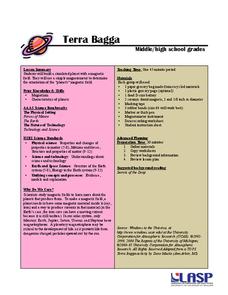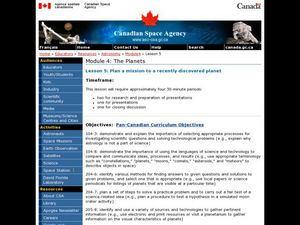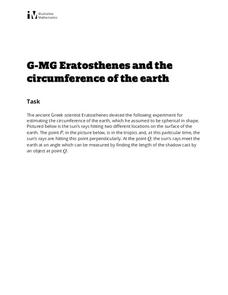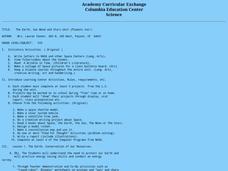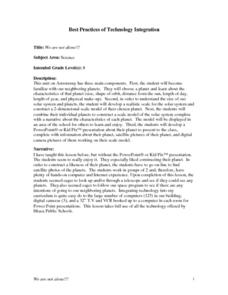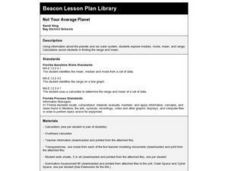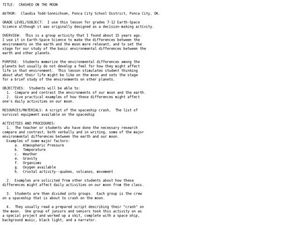University of Colorado
Strange New Planet
The first remote sensors were people in hot air balloons taking photographs of Earth to make maps. Expose middle school learners to space exploration with the use of remote sensing. Groups explore and make observations of a new...
Curated OER
Describing the Planets
Kids love learning about space! In this short plan, your young Spanish speakers read Los Planetas and talk about the nine planets. By the end, they should be able to name and identify each of the planets and add some descriptive words....
Laboratory for Atmospheric and Space Physics
The Planets and Scale
Scholars gain an insight into the relative size of planets and distance between inner and outer planets with the help of informational text, a data table, and a series of four questions.
Curated OER
Discovering Saturn, The Real "Lord of the Rings"
Reading, writing, and rings! A lesson from NASA combines space science with authentic reading and writing tasks. Included in this lesson are pre-reading activities, four mini informational booklets on Saturn, a structured...
Curated OER
Making Models of the Solar System
Students make several models of the solar system to learn the positions of the planets in the solar system as well as relative distances and sizes. Creation of these models will help them identify the planets by size, shape, color,...
Curated OER
Exploring the Sky: Reading Maria's Comet
Discover the science behind astronomy. After reading the book Maria's Comet, which is about a young woman who breaks new ground by becoming a female astronomer, young learners practice reading comprehension with...
Curated OER
Planet Impact!
An amazing information-packed lesson plan allows your space scientists to crash a virtual comet into Jupiter and learn how the angle, distance, speed, and mass influence the outcome. Click on "Back to the Lesson" to access the...
Laboratory for Atmospheric and Space Physics
Where Are We Going?
Come take a ride on the space bus! Scholars go on an imaginary trip to pick up their peers from the inner and outer planets while reinforcing math skills. First, learners round decimals to identify each planets' distance from Earth....
University of Colorado
Terra Bagga
One way to identify possible volcanic activity on other planets is by testing the planet for magnetism. A science lesson plan begins with pupils constructing their own planet from a dead battery, magnets, paper, and tape before...
Curated OER
Plan a Mission to Recently Discovered Planet
Students plan a mission to a recently discovered planet. In this science instructional activity, students research spacecraft design, distances in space, long-term missions in space, and life-sustaining planets. Students work in groups...
Curated OER
Hoop Trip To The Planets
Students practice locomotor patterns already introduced while reinforcing facts about each planet.
Illustrative Mathematics
Eratosthenes and the Circumference of the Earth
The class gets to practice being a mathematician in ancient Greece, performing geometric application problems in the way of Eratosthenes. After following the steps of the great mathematicians, they then compare the (surprisingly...
Curated OER
Good Vibrations Remote Sensing data Collection: Thermal Emission Spectrometer
The Mars Global Surveyor spent two years creating a mineral map of the planet Mars using thermal emission spectrometry. To help young astronomers understand this remote sensing instrument, have them simulate how data is collected and...
Curated OER
Visual Arts- Planetary Travel Brochure
Students research the planets and create a "travel brochure." In this space science lesson, students read the book Magic School Bus: Lost in Space and identify various properties of each planet. Students create a brochure for a specific...
Curated OER
The Earth, Sun, Moon, And Stars
Fifth graders explore the solar system. In this solar system unit, 5th graders investigate numerous projects while rotating through learning centers. Students write about space and construct a space shuttle model. Students practice map...
Curated OER
We Are Not Alone!!!
Eighth graders explore the area of astronomy. They explore Earth's neighboring planets. Students research a planet's characteristics. They develop a scale model of the solar system and a narrative about the planets.
Curated OER
Solar System Search
Students research topics related to space and the planets using the Internet. They explore various websites, construct scale models of the solar system, and create a travel brochure using HyperStudio computer software.
Curated OER
Not Your Average Planet
Fourth graders explore median, mode, mean, and range using information about the planets and our solar system.
Curated OER
The Earth, Sun Mood and Stars Unit (Planets too!)
Fifth graders prepare five activities to do then show their energy saving skills. In this investigative lesson students create five projects then participate in an energy saving demonstration.
Curated OER
Cargo Activity Practice
Students examine the cargo load that is needed during the simulation of a space rescue mission. They brainstorm in order to think of possible things needed onboard in storage. Then students create an inventory list that includes water...
Curated OER
My Spacecraft to Saturn
Students discover problems that NASA must deal with on a daily basis. They work together to think of solutions and sketch their own idea of a spacecraft. They discover the concept of engineering.
Curated OER
Journey To The Solar System
Third graders engage in a lesson to find different facts and connect them to the concept of the solar system. They conduct research using the technology integration of the internet. Using the information the students create a classroom...
Curated OER
Crashed On the Moon
Pupils compare/contrast the environments of our moon and earth, and examine examples of how these differences would affect their daily activities on our moon. They develop lists of emergency supplies to bring if their spaceship crashed...
Curated OER
On Jupiter
Students tour Jupiter. In this scenario based lesson, students examine the size of Jupiter and make models of the other planets in the solar system to show how large Jupiter is compared to the other planets.










